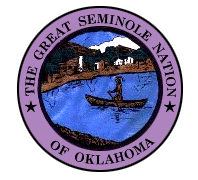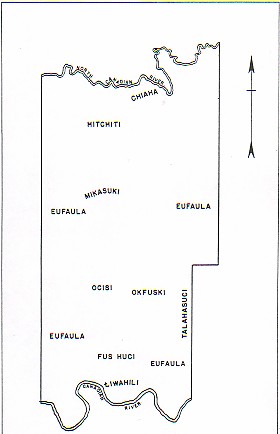

OKLAHOMA SEMINOLE TOWNS OF 1900
![]()
When the Seminoles were still living in their old country in the southeastern part of the United States, and important form of local grouping among them was the town (talw'a). At the time of removal, the Indians transferred this feature of their social organization to their new habitat in the west and though the towns became politically subordinate to the newly formed tribal government and though it changed in other respects, it continued to be a significant aspect of Seminole life. The Seminole towns in Florida moved about so frequently and altered their names so often that it is next to impossible to follow their history in any connected manner. Even after they had settled in Oklahoma it is difficult to unravel their later vicissitudes.
There is a distinct difference between Seminole and Creek towns, for the latter each had a proud traditional history that the Seminole towns, which had a composite origin and relatively later formation, lacked. Even today this difference is noticeable, the surviving Upper Creek towns, or bands as they are now called, consisted entirely of Negro freedman and remaining twelve of Indians. The names of the Indian towns were as follows: Hitchiti, Mikasuki, Chiaha, Eufaula No. 1, Eufaula No. 2, Eufaula No. 3, Thliwahili, Ocisi, Okfuski, Talahasuci, Fus Huci and Newcomers.
Hitchiti and Mikasuki towns spoke variant but mutually understandable dialects of the Hitchiti language; the remainder spoke Muskogee proper. The difference in language resulted in a certain social barrier between Hitchiti and Mikasuki on one hand and the other towns on the other, for Muskogee and Hitchiti are mutually unintelligible. Hitchiti town and Mikasuki are said to have visited each other more than the remaining towns, and though Hitchiti was on very friendly terms with Chiaha, its neighbor to the north, the Mikasuki are reported to have kept mostly within their own linguistic division.
Ideally speaking, a Seminole town consisted of a fairly compact group, which in addition to being a political subdivision of the Seminole Nation, maintained its own ceremonial square ground where the town dances, ceremonies, and festivities were held. The towns comprising the list given above did not all conform to these criteria. The three Eufaula towns were separate local divisions, but were apparently formed by the segmentation of one original group, and continued to participate in ceremonies at a single square ground. Fus Huci was originally an old Creek town which migrated to Florida; after moving to Oklahoma, it gave up its square ground and joined tiwahili, although continuing in existence as a separate local group. The latter town also incorporated Kan Hatki, a second Creek town. Newcomers town kept together for a short time after the Civil War, but then scattered among the other towns and ceased to maintain a square ground, although retaining its representation on the tribal council.
The size of the Seminole towns varied greatly. Hitchiti numbered but a dozen families at the close of the century, a mere hamlet, whereas Mikasuki counted well over a hundred. This variation in size may have affected the degree of compactness of the local settlements, though the pattern of house distribution was apparently much the same. Each household possessed it own log cabin and cultivated it own fields. The placing of the former was directly related to the available water supply, so that a typical settlement was built along the low ridges flanking one of the numerous small creeks in the region. The houses might be anywhere from fifty to several hundred yards apart; apparently the settlement tended to spread in later times, so that in spatial terms the community exhibited a loose grouping of cabins along a water course. The land in the nation was of very unequal quality and the Seminole tended to utilize the small areas of bottom land; consequently, a family's fields may be a half mile or more from the cabin that housed them.
Socially, however, the local group seems to have been a relatively compact unit. In the late spring and summer, particularly at the time of the Green Corn dance and the tribal council meetings, there was considerable mingling of people from up and down the Nation. The men had a wider range of social contacts than the women. But for the most part, members of a town kept largely to themselves. Marriages were said to have been seldom contracted outside the local group. In case such a marriage took place, whether the man or the woman left his or her town to take residence in that of the spouse seems to have been dictated by circumstances. In either instance, change of residence theoretically did not result in change of town affiliation, the absentee retaining his or her membership in the town of birth. Children of such a couple were supposed to belong to the town of the mother.
The town was active in three spheres: the ceremonial, the political, and the economic. The ceremonial organization reflected its Creek origin and was closely similar to Creek practice. The town square ground was situated in a pleasant spot easily accessible from the nearby homes of the people. here the town dances were held, the most important being the Green Corn dance in the late spring or early summer. The officers, arrangement of the found, the seating of the different clans in the various beds, and the ceremonial procedure all followed a similar pattern.
In the political sphere the town was a subdivision of the Nation, being represented on the national council by three members. The degree of political autonomy which the town possessed in relation to the larger national unit was slight, at least in later times. Apparently there was a fairly early consolidation of political power in the hands of the tribal government, with the result that the distinctions between the Seminole towns became less and less. This may well account for the tendency of the town members to scatter in later years.
The economic activities of the town were under the supervision of a third set of leaders. These consisted of the "little chief" (mi-kkoci) and from two to four assistants, who directed what little communal labor the townspeople undertook. There were no communal town fields and such labor usually consisted only of rail splitting, though there was a time when the townspeople plowed their fields in common. Also once a year at a stated time, every male citizen was supposed to devote several day's work to repairing the few wagon roads that ran through the Nation.
Seminole towns were originally classed by the Indians according to a dual division. some towns were known as "white" towns, others as "red." The towns belonging to a single division were to be of the same "fire." This dual division of towns apparently lost its significance rather early among the Seminoles. It determined the sides for the inter town ball games, but these were relatively infrequent; perhaps because their tribal unity was greater, the Seminoles were much less given to such games than the Creeks. Also at the time of the Green Corn dance a town would send special invitations to other towns of the same division or fire. But aside from this, there is no history of any other function of the white-red dual division. There was apparently no great feeling of solidarity among towns of the same fire, nor of opposition to those of the opposite fire. The northernmost town in the Nation, Chiaha, and the southernmost, tiwahali, never cared greatly for each other though they belong to the same fire, and in the old days there was a certain amount of political rivalry between the southern and northern districts of the Nation. The two northernmost towns, Chiaha and Hitchiti, seem always to have been on friendly terms, and when Hitchiti gave up its stomp ground the non Christians danced at Chiaha, though one town was white and the other red. Inasmuch as one would expect the dual division to be particularly important in such ceremonial matters, one can infer that it had lost a great deal of its importance to the Seminole.
The accompanying figure shows the approximate location of the Seminole towns or settlements about the year 1900. Certain towns are difficult to locate, particularly Eufaula, which had largely scattered by this time. It should also be noted that under the laws of the Seminole Nation neither individuals nor the so-called town owned land; this was held by the Nation.

Seminole Towns in 1900
![]()
© 2001-2002 Seminole Nation, I.T.
18-Dec-2001